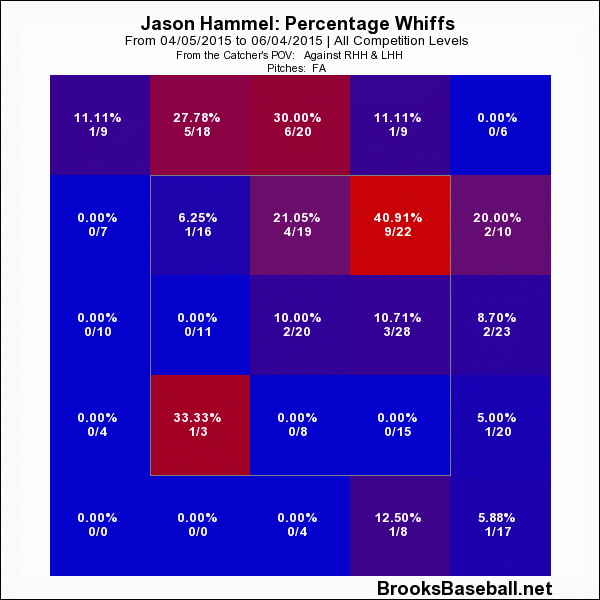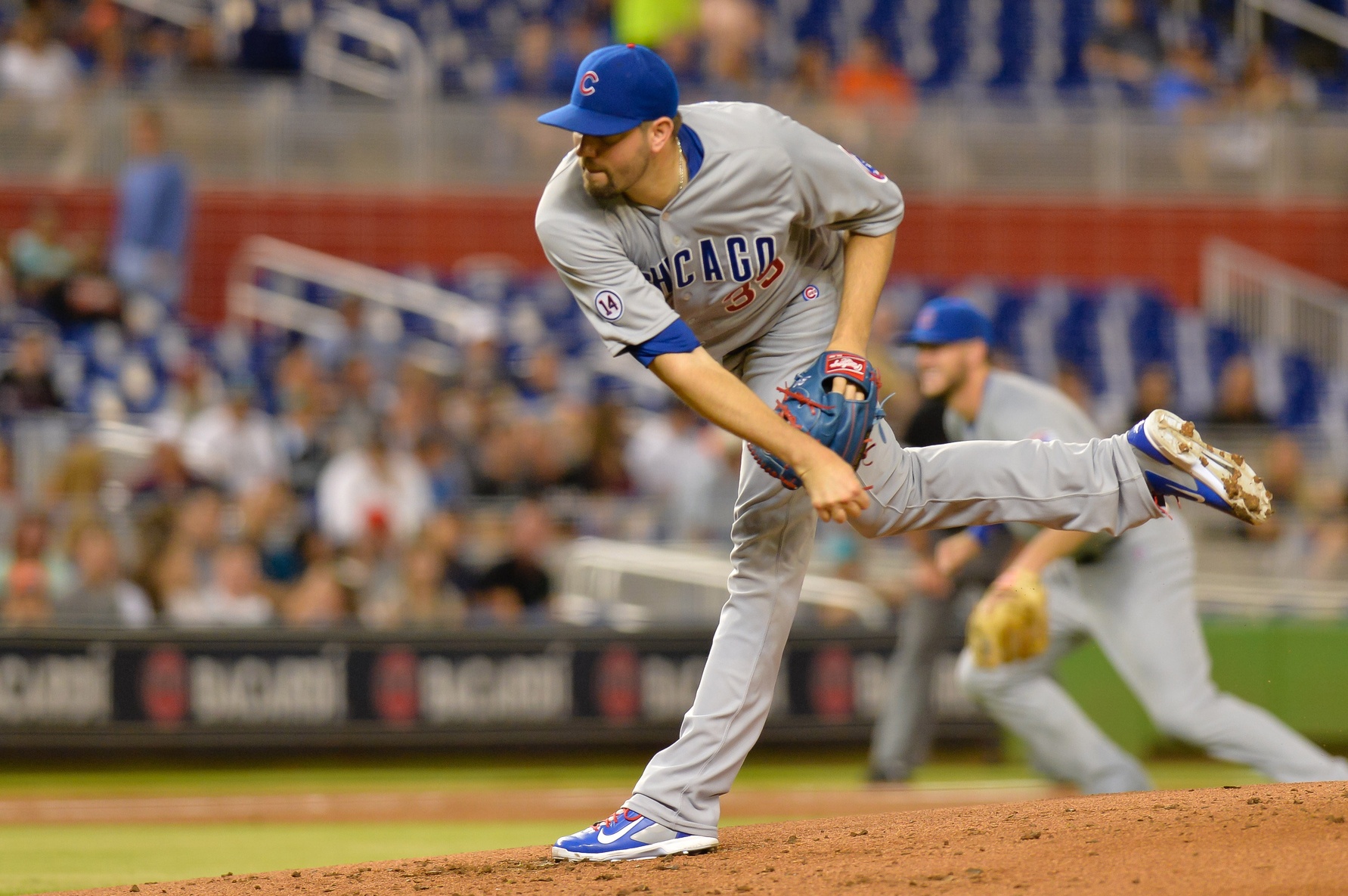This piece originally appeared on Baseball Prospectus
If you’re a follower of the Cubs, you’re aware that this season has been a bit of an up-and-down experience. After a six-game winning streak in mid-May, which took them to a season-high six games over .500, the Cubs have gone 7–9, with the offense being the biggest culprit for their struggles. In seven of those nine losses they’ve scored three or fewer runs, and actually did so in five of their seven victories, too. To get those seven wins, it’s clear the Cubs have had some nice pitching performances, and for the most part, that’s come from the starters.
When most hear that the Cubs’ starting pitching is leading the way of late, they’re likely to point to Jon Lester, he of the seven-year, $155 million contract signed last December. His spiffy 1.76 ERA in May certainly has helped the Cubs stay afloat during this last month, but he also is the owner of essentially 0 pitcher WARP (the new version, based on DRA), dead last for this current rotation group. Jake Arrieta has a 3.04 ERA, a 26.6 percent strikeout rate, a 5 percent walk rate, and a strong 1.2 PWARP. Tsuyoshi Wada has been impressive since joining the rotation (while not much of an innings-eater, he’s put up a 2.30 ERA with 19 strikeouts in 15 2/3 innings in his three starts) and Kyle Hendricks has been better of late.
But, as you can probably surmise, this column is about none of those arms. Jason Hammel, for the second year in a row, has been brilliant in the early going for the Cubs. He leads the staff with a 2.82 ERA, a career-high 26.3 percent strikeout rate, a breathtaking 2.7 (!) percent walk rate (fourth in baseball), a 9.86 K/BB ratio (third in baseball), and 1.2 PWARP. Hammel was expected to be a solid mid-rotation piece for the Cubs, but in the early going, he’s been much more.
We’ve seen this before from Hammel. Maybe not to this extent, but success in short stretches isn’t anything new. When he impressed early in his career, one of the keys was his ability to induce the groundball, relying on his defense while striking out guys at a slightly above-average rate. However, this latest version, one that appears to be improved compared to what we saw with the Cubs in the first half of 2014, is utterly dominant.
And to be clear, Hammel, despite posting a sub-3.00 ERA in over 100 innings during his first stint with the Cubs, is significantly better now. He’s striking out more hitters and walking fewer while allowing weaker contact, all leading to him being a better overall pitcher. But while he was a revelation for the Cubs for the first three months of the 2014 season, Hammel did hit quite a rough patch after being traded to the Oakland Athletics last July 4th. What changed when he arrived in the Bay Area and what appears to have come back to him as he’s returned to the North Side is really quite simple: fastball command.
While with the Cubs in 2014, Hammel was throwing his fastball on the outer edge of the plate, or even off it, ensuring that if contact was made, it was unlikely to be squared up.

In his 67 2/3 innings with the A’s, there were way too many fastballs left up and over the plate.

And this season, he’s once again regained command of that fastball, painting the outer edge and getting the desired results.

Here’s the usage pattern of Hammel’s four-seamer of late and the ensuing results.
| IP | % Used | ISO Allowed | HR Allowed | |
| 2014 (Cubs) | 108 2/3 | 32.5% | .178 | 3 |
| 2014 (A’s) | 67 2/3 | 37.2% | .305 | 9 |
| 2015 | 67 | 31.4% | .177 | 3 |
But it wasn’t just the long ball that hurt Hammel while in Oakland: He also wasn’t striking out as many batters. His strikeout rate plummeted from 24 percent with the Cubs to 19 percent while with Oakland. The fastball alone can’t be blamed for that drop because he used the four-seamer more often in Oakland and induced whiffs per swing at just a slightly lower rate (18 compared to 19 percent).
The issue here rests primarily on Hammel’s inability to make opponents swing and miss on his slider, which went from getting 42 percent whiffs per swing down to just 27 percent after Hammel was acquired by Oakland. He was throwing the pitch about a mile and a half slower while with the A’s, and he’s back to throwing it harder this year. The positive results have come back as well.
But again, it’s all about the fastball. This season, Hammel is actually using the pitch a tick less than he did while with the Cubs last year, and significantly less than while with Oakland. In fact, thus far, he’s using it at the second-lowest rate in his career. However, it’s been more effective than ever before, inducing 24 percent whiffs per swing, good for ninth in baseball according to Brooks Baseball. And while I showed above that he’s pounding the outer half of the plate with his fastball, he’s actually inducing whiffs with the pitch at the top of the zone, getting hitters to offer at the four-seamer with more frequency, in that part of the zone and in general, than in the past.

The slider remains effective (though slightly less so, as far as whiffs go, inducing 36 percent per swing, still good for 13th in baseball according to Brooks Baseball), and he’s using it at a higher rate (37 percent) than ever before in his career. And while the return of velocity is a boon, in all likelihood, it’s the effectiveness of his fastball, his ability to command it, and the opponents’ inability to make consistent contact that are allowing Hammel to utilize his slider more often.
The impressive effectiveness of two pitches has led to opponents swinging at his pitches 48 percent of the time (a three-point jump from last season) and offering at pitches outside of the strike zone 33 percent of the time (a four-point jump from last season). And while he’s not staying in the zone in a Bartolo Colon–like fashion, he’s there enough (50 percent) and commanding his pitches so precisely that it all adds up to a bump in his strikeout rate and a truly impressive walk rate.
With the slider delivering results at nearly the same level as when Hammel was at his best, paired with a four-seamer that, while no faster than before, is proving to be one of the more effective ones in baseball, the Cubs righty has emerged as one of the bigger surprises on the mound in the season’s first two months.
Lead photo courtesy of Steve Mitchell-USA TODAY Sports
